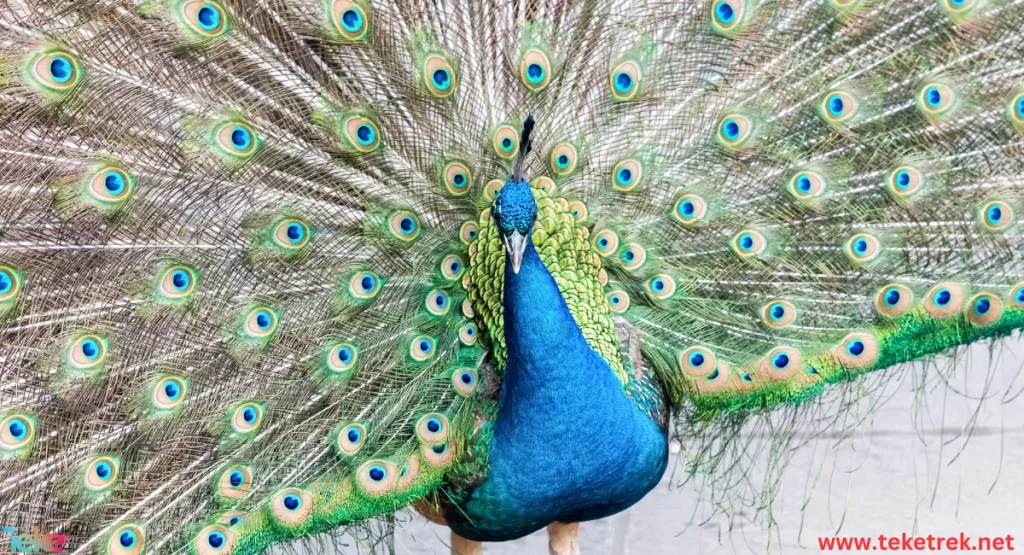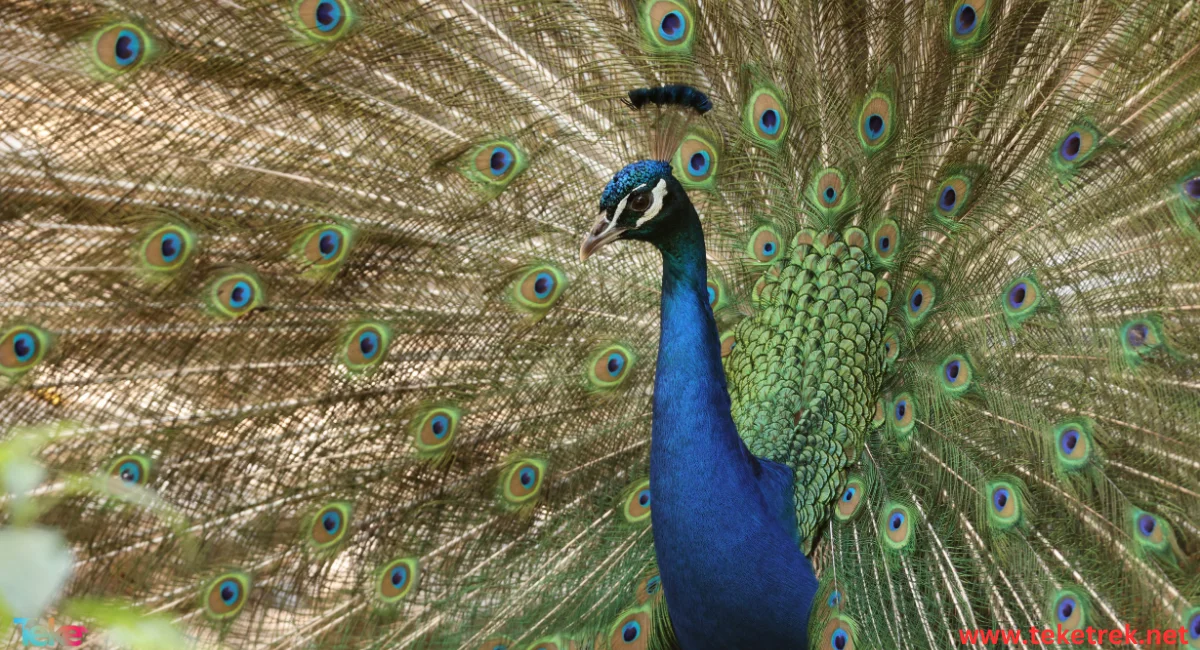The peacock is undoubtedly one of the most captivating and awe-inspiring birds, often referred to as the “king of birds.” It is distinguished by its unique beauty and vibrant, colorful plumage. Its massive tail adorned with numerous iridescent feathers symbolizes luxury and beauty.
This bird inhabits wild areas, grasslands, and forests across the continents of Asia and Africa, displaying an impressive ability to adapt to various environments. With a body length of approximately 2 meters and weighing around 10 kilograms, it is a large and mesmerizing bird.
In this article article on the Teketrek website, we will explore this remarkable bird and delve into essential information regarding its ecology, geographical distribution, species, and much more. Stay tuned for an exciting journey.

About the peacock
The peacock is inherently social by nature, preferring to live in groups consisting of pairs up to 5 pairs, characterized by organized and tranquil lives.
1. Reproduction:
- Peacocks reach maturity in their third year when their tail feathers are fully developed, and they begin courtship. After mating, the female builds her nest on the ground and lays approximately 4-6 eggs in the wild, with the female’s nutrition playing an active role in increasing the number of eggs.
2. Preferred diet:
- The peacock’s diet mainly consists of insects, worms, seeds, fruits, and grains. It also includes grasses and small herbs. Peacocks may also feed on fresh plants such as leaves and buds. Peacocks tend to have a diverse diet, depending on the environment they live in and the available resources. They prefer freshwater rich in mineral salts.
3. Peacock’s habitat:
- Peacocks live in grasslands and temperate forests in Asia and Africa, preferring green environments and areas with dense vegetation where they can easily find food. They can also live in mountainous and desert areas if suitable conditions are available.
- Indian Blue Peacock: Abundant in India, Sri Lanka, Kashmir, Nepal, and Pakistan, it is characterized by its preference not to migrate or travel long distances.
- Green Peacock: Found in the tropical forests of Southeast Asia, including China, Indonesia, Laos, Vietnam, and Thailand. It can also live in savannas, grasslands, and agricultural lands.
- Congo Peacock: Considered an endangered species, it lives in Africa and is the national bird of the Republic of the Congo. It is abundant in the Salonga National Park in the Republic of the Congo.
The species of peacocks
There are several species of peafowl, differing in various aspects such as shape, size, and color. They can be categorized as:
Domesticated Species:
- Black-shouldered
- Black Spalding
- Black-shouldered Split
- Purple
- Blue Spalding
- Bronze
- Burmese Green
- Brown Pied
- Brown Spalding
- White-eyed Pied
- Spalding
- Indian Blue
- Indian Blue Split
- Indian Chinese
- Java Green
- Black Pied
- Silver Pied
- White
- Midnight
- Charcoal
Wild Species:
- Indian Peafowl
- Congo Peafowl
- Green Peafowl
- White Peafowl
- Bronze Peafowl
- Peach Peafowl
Indian Peafowl: The most distinctive species, with attractive plumage mixed with blue and green, a bright blue head, and a colorful crest.
Green Peafowl: This endangered species has stunning plumage, ranging from 1.2 to 1.6 meters in length, and features the same green and blue colors.
White Peafowl: Considered a rare species, it is a peafowl with white plumage.


The importance of peacocks
The peafowl holds special significance, as evidenced by the following points:
1- Environmental Balance: Peafowl play a vital role in maintaining environmental balance in their habitats by regulating insect and plant populations.
2- Tourist Attraction: The presence of peafowl is considered attractive and exciting, attracting visitors and enhancing tourism in those areas, especially with the male peacock’s colorful and mesmerizing tail.
3- Scientific Research: Peafowl are used in scientific research, either as subjects for behavioral studies or genetic analysis and biodiversity studies.
4- Cultural Heritage: Peafowl holds cultural and historical value in some cultures, symbolizing beauty and luxury.
5- Food Source: Some communities use peafowl meat as a traditional food due to its richness in protein and vitamins.
6- Fashion Industry: The fashion industry utilizes peacock feathers for their beauty and luster, contributing to its development.
7- Agriculture: Farmers utilize peafowl manure as a natural fertilizer rich in nutrients, enhancing soil quality and boosting crop productivity.
8- Entertainment: Peafowl are used in some shows and entertainment events as attractive and interesting birds.
9-Promoting Environmental Conservation: Awareness campaigns leverage the beauty and elegance of peafowl to underscore the significance of conserving biodiversity and protecting wildlife.
Interesting facts about peacock
The peacock is vertebrate animal, it boasts several fascinating facts, here are some of them:
1. The peacock’s tail is among the longest in the bird kingdom, consisting of colorful feathers that display beautifully and mesmerizingly when fanned out.
2. The male peacock, known for its flamboyance, displays its colorful plumage to attract females and assert its health and strength.
3. Peacocks emit a loud call resembling a scream upon waking in the morning or when alerting to danger.
4. Despite its large size and beautiful plumage, the peacock cannot fly long distances, and its flight is limited to short distances.
5. Peacocks are considered long-lived birds, with a lifespan of between 10 to 20 years in the wild, and in captivity, their lives can reach 30 years or more.
6. Peacocks possess immense muscular strength in their legs, enabling them to carry heavy weights and defend themselves.
7. Maintaining the peacock’s male, known as the “train,” requires significant care, including proper nutrition to preserve the quality and beautiful color of their feathers.
5 frequently asked questions about peacocks
1- What do peafowl eat?
Peafowl feed on a variety of foods such as grass, flowers, insects, reptiles, worms, bread crumbs, and grains. They also prefer freshwater filled with mineral elements.
2- How many eggs does a female peafowl lay?
A female peafowl lays one egg per day for 6-10 days, totaling between 6-10 eggs per month.
3- What is the average lifespan of a peafowl?
Peafowl have long lifespans, typically ranging from 10 to 25 years in the wild. With proper care from experts, they can live up to 50 years, fostering the potential for long-term relationships to develop with them.
4- Why do peafowls open their feathers?
The male peafowl displays its colorful feathers as part of mating and boasting behavior, aiming to attract females and showcase beauty, strength, and social status. It also emits various sounds to attract female peafowl.
5- What is the name of peafowl in English?
The male peafowl is known as a peacock, while the female is called a peahen.
At the end of this article about peafowl and the most important information related to this magnificent bird. It is a creature deserving of appreciation and admiration, painting a beautiful picture with mesmerizing colors that add a special charm to the world of nature and animals.






